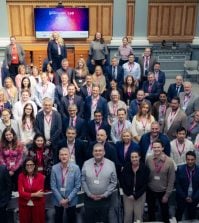‘They need a paradigm shift’: How government can empower citizen-centric digital innovation

According to the UN e-government ranking the UK led the way in digital transformation five years ago, but its performance has deteriorated since. This decline is happening just as citizens expectations of government digital services are rising. At a recent webinar hosted by Salesforce, experts explored how civil servants can create truly citizen-centric public services – and explained the advantages of using existing technology rather than building systems from scratch
It is now clear that citizens expect government services to be provided to the same quality online as they encounter when shopping on their computer or using a bank’s digital services. So said Iain Patterson, former CIO and transformation leader in the civil service, when speaking at a webinar looking at how government can empower citizen-centric digital innovation.
Patterson, whose roles in UK government include working for the Cabinet Office, the Driver and Vehicle Licensing Agency, Student Loans Company, and Post Office, as well as the London 2012 Olympics, highlighted that people now “expect consistency” of digital service from the public as well as the private sector.
Research from International Data Corporation (IDC) presented to the webinar also bears this out. Massimiliano Claps, research director, IDC UK, explained that citizens want modernised digital services, especially post-pandemic. Recent surveys by IDC revealed that this was the public’s number one priority in terms of where they would like investment focused in the post-coronavirus recovery.

However, while UK civil servants have historically led the way on digital transformation with programmes such as the G-Cloud, the Digital Marketplace, and the Government Digital Service’s design standards all improving the citizen experience, according to the UN e-government ranking the UK’s performance has fallen behind others over the past five years.
This trajectory “reflects what we’re seeing in our research as well,” Claps said during his presentation on how cloud-based platforms can accelerate the transition to digital services for citizens. “It’s the transition from simply putting up a one-stop shop portal or a customer or citizen contact centre, towards being able to redesign the end-to-end service experience.”
Such an approach was enabling services to be planned around groups of citizens with similar needs he said, and being used “to anticipate some of their needs and preferences when there are changes of circumstances”. This is the direction some governments across Europe, as well as industries such as the UK’s financial services are moving in, Claps said, “while the UK government is still dealing, in a few instances, with PDF forms”.
COVID-19 has been a catalyst for ‘radically transformed experiences’

Paul Pick-Aluas, the head of digital transformation Europe public sector at Salesforce, which hosted the webinar, noted the pandemic had accelerated digital transformation in the UK at national, regional and local levels and proved it’s possible to deliver “radically transformed experiences” very quickly. “We saw agencies large and small use data and technology in novel ways and deliver functional solutions at unprecedented pace.” He pointed to the JETS programme at the DWP to demonstrate just how fast the civil service could innovate. The programme went live in just 10 weeks, and handled 1,000 referrals in the first three months, he explained. “And there are countless other examples like this, across the UK public sector and globally.”
However, while there has been a lot of focus on modernising the front end of service delivery through improved government websites in recent years, more could be done to join services up, the panelists agreed. Front office functions were not always well connected to back-office elements, and few government processes are “truly managed end-to-end,” said Pick-Aluas. Taking a more holistic view in the next wave of transformation, and using tools such as automation and AI technologies, would allow the civil service to “build back better through efficient, connected, informed processes”.
This was a point Patterson made too. While the front end of government services were very orientated towards being user-friendly and citizen-centric, back-end systems “weren’t fundamentally changing in line with that,” he said, and therefore remained “restricted in the capacity of change they could make”.

Moving away from legacy systems and creating a smart back end, with “push not pull” technologies would allow far more synergy and flexibility, he said. “If your car needs taxing, a message coming out from the back end telling you it needs taxing, and allowing you to use your phone to pay, would be far more progressive than getting some sort of warning and then being driven to a website to make the transaction happen.” Taking this a step further, smart cars could tell drivers when their vehicle needs an MOT and even book owners into a test centre nearby at a time convenient to them.
One barrier to this type of innovation were lengthy bureaucratic processes but there had been some recent progress in this area. Patterson praised HMRC for very quickly launching schemes to keep citizens and businesses funded through the lockdowns with the temporary suspension of the usual time-consuming checks and processes. “I think an awful lot of lessons probably have been learned. It’s now turning that into material practice,” he said.
Tools that allow governments to continuously test and innovate
Claps explained that digital transformation teams told IDC that current tools and processes were not helping them to continuously test and innovate. “They need a paradigm shift, using tools that provide out of the box integration, out of the box certification, low code or no code capabilities, so that it isn’t only the super deep technical expert who can work on change and transformation,” he said. Moving to the cloud would provide these modular and configurable capabilities as well as allowing small- and medium-sized enterprises to work on government contracts on a much shorter timescale. “The outcome will be an acceleration [in] getting to the next step of citizen-centric service innovation,” he said, and ultimately eliminate duplication and result in better services for citizens.
Civil servants could learn from the travel and retail sectors which had become much more customer-centric. In particular, the way these sectors used data and insights from customer feedback to continuously improve services in real time was something the panelists felt the public sector was often missing. Enabling feedback to be captured at the point of contact, for example at a customer centre, would allow for continuous improvement explained Patterson. “You can iterate really quickly, within two weeks, a week – fundamentally it’s about going faster,” he said.

Simon Collinson, head of UK public sector at Salesforce, said that once organisations opened up and started engaging more with their audience, whether citizens or businesses, they “get on this virtuous circle,” of continuous feedback and service improvement. “You build a wealth of information that comes back and drives that next wave of change,” he said.
Pick-Aluas also pointed to retail as a good example of a sector taking advantage of available technology. “The Amazon experience is something to borrow from, even in government service delivery,” he said. “I think if you look under the hood there, you might gain some insights into the technology approach that these kinds of companies take.”
He also highlighted Uber as an example of a firm creating “very custom tailored experiences” – but only where they need to. Both companies were making use of existing technologies for case management, automation and application programming interface (API) management rather than building things from scratch. “They’re very much leveraging platforms. It’s only for that specific experience that they go and build something custom. I think this is something that governments still need to catch up to with industry.”
Indeed, this government tendency to build bespoke systems from scratch rather than leveraging existing technology was identified by the panel as one of the biggest barriers to deeper innovation.
Patterson agreed that while it’s right for the civil service to want to take control of the design and architectural decisions, it still makes sense to use existing tools and platforms where possible. “I think that’s where government needs to get to, [using] those common elements. Don’t go building everything,” he said. “You can’t build a better CRM solution than a multi-billion pound software company.” There was also a danger of “adding huge complexity and risk” in terms of the cybersecurity threat when building something bespoke compared to something that has “millions, or billions potentially, spent on making sure it’s cyber secure,” he added.
But while putting the right technology in place will help to develop the citizen-centric services people clearly want, a “mindset shift” for government is also required, concluded Collinson. “The tech is simply an enabler for the change. It’s more of a case of what can we, as an organisation, learn by truly understanding the experience of our users, our audience, our endpoints – and how can we use that to be a better department?”
This Salesforce webinar Empowering citizen-centric digital innovation was held on 30 November 2021, with support from Global Government Forum. You can watch the 75-minute webinar via our dedicated event page.

















